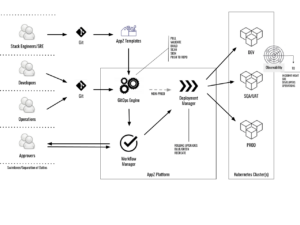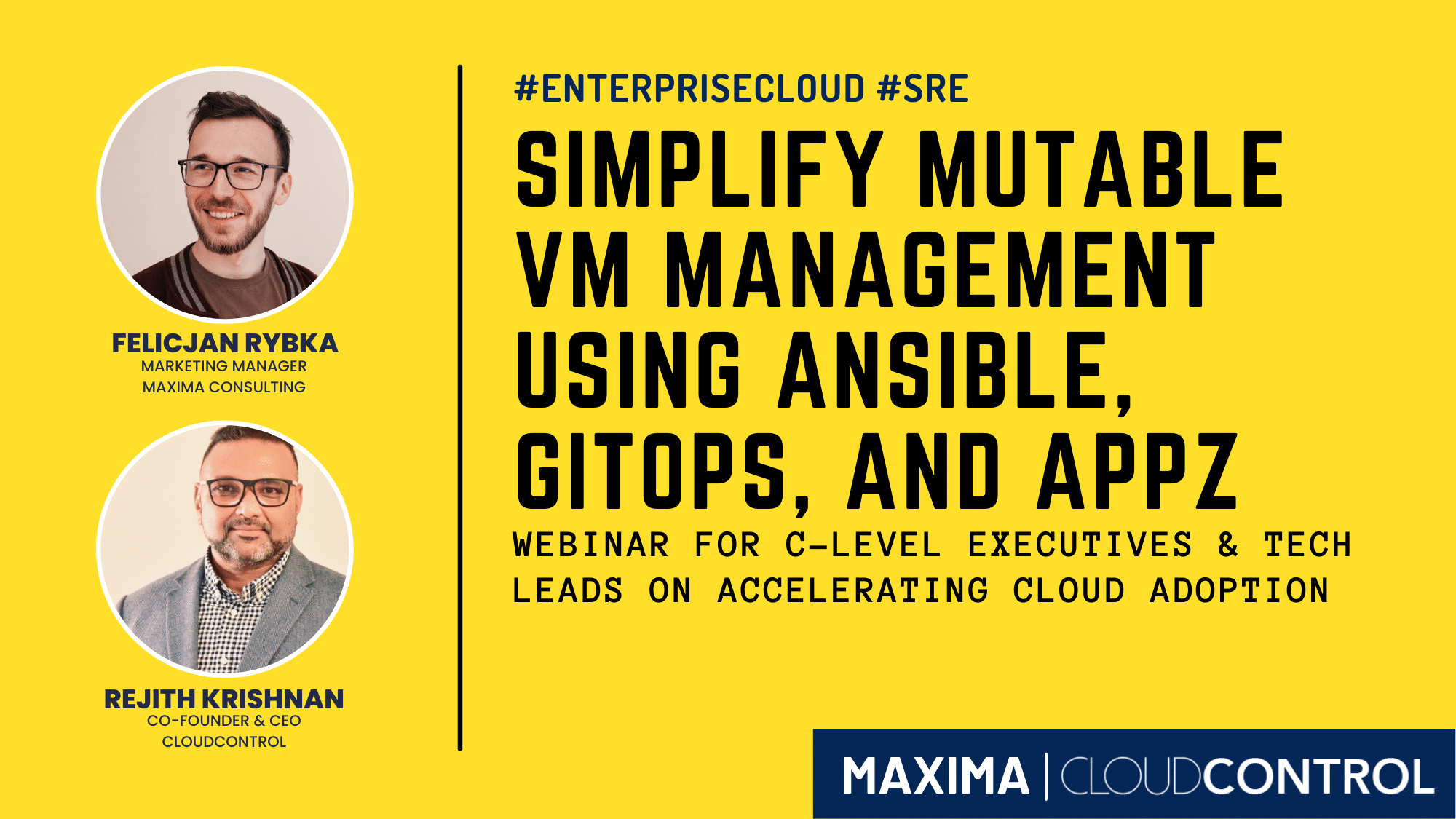Simplify Mutable VM MANAGEMENT using ANSIBLE, GitOps, and AppZ
A Webinar for C-level Executives and Tech Leaders On Accelerating Cloud Adoption
Learn how to simplify mutable VM management using Ansible, GitOps, and AppZ! In a recent webinar, Rejith Krishnan, Founder and CEO of Cloud Control, and Felicjan Rybka, Marketing Manager of Maxima Consulting, shared their valuable insights on strategies for accelerating cloud adoption.
What do you Gain?
Participants will gain valuable insights on
- Deploying applications using GitOps,
- Achieving a faster time to market, and
- Reducing ownership costs.
How can AppZ streamline processes and facilitate the provisioning and management of virtual machines efficiently?
When it comes to the cloud, businesses want it to have a better location to host applications. And they aim to improve their speed to market and scalability. Organizations want to ensure that
- The cost of ownership is low,
- There is better agility,
- They can interact better with their clients,
- Data security is improved, and
- They can look into innovations more effectively.
These are the primary objectives that a company hopes to achieve through cloud adoption.
Our AppZ platform provides templates for any cloud-based action, such as deploying an application, launching a website, deploying a patch, or releasing a new version of an application. As the cloud is software-defined, anything can be written and scripted because each provider provides APIs with their own templating and scripting mechanisms. Our meticulously crafted, multi-cloud-compatible templating approach embraces the full spectrum of cloud providers, leveraging each platform’s unique scripting and templating capabilities. This comprehensive solution empowers organizations to seamlessly navigate the intricate landscape of cloud computing, ensuring optimal compatibility, flexibility, and efficiency.
A prime example to illustrate this concept is a website. When deploying a website, it’s possible across multiple cloud platforms, ensuring a consistent user experience for your operations and development teams. This is made possible through the utilization of templates.
We have developed intelligent templates that efficiently determine where the cloud is being deployed, and these templates seamlessly incorporate the customer’s assets, including web content, website design, graphics, and overall aesthetics. Using Git as the single data point allows for more effective change management via Git flow. The Git repository is then seamlessly connected to the customer’s account on the platform, where the templates are utilized to deploy content or artifacts into the cloud. Our platform offers a wide array of templates, catering to diverse use cases that meet every customer’s cloud needs.
How many tools can AppZ replace? And what would be the potential savings associated with that?
To effectively achieve the desired cloud objectives, it is crucial to implement an automation system referred to as a pipeline in the cloud realm. This pipeline will securely transfer and integrate all assets into the cloud while emphasizing the need for change management throughout this process. Security scanners will also be required to guarantee that the application installed is secure and that hardened images are used. Once implemented, observability is needed since the goal is to make the cloud seem like an appliance, which is one of the most efficient ways to use the cloud.
To grasp the workings of the AppZ platform, it is crucial to understand the necessary tools. In the below-given architecture, there is an infrastructure that can be AWS, Azure, Google Oracle, etc. Within the architecture, on the right-hand side, you’ll find the infrastructure which houses all the running workloads. On the left-hand side, various individuals participate in the entire process. Many enterprises employ in-house or outsourced developers to create new applications and software and resolve bugs. These developers rely on Git for source control, followed by a pipeline that builds the binaries and deploys them to the cloud. A well-designed pipeline, management system, and observability functionalities are needed to oversee the deployments. Numerous tools can facilitate each of these aspects. We consolidate all these components, integrating observability with effective dashboards, incident management tools, and collaboration engines like Slack and email.
Our platform offers customers various choices for deploying to single or multiple clouds. We achieve this by leveraging various existing open-source tools. We rely on the widely adopted Prometheus for observability, which handles time series data and stores relevant metrics information. Regarding logs, we utilize Elastic as our primary choice and extend support to vendors like Datadog and Splunk. Our primary objective is to ensure customers experience a seamless and standardized deployment process while maintaining flexibility and adhering to all necessary licenses.

Figure 1: AppZ Platform
What sets AppZ apart from its competitors? How can AppZ differentiate itself in the market?
Businesses frequently encounter the task of harnessing the power of Kubernetes, a formidable tool brimming with immense potential. Despite its initial complexity, Kubernetes can empower organizations to accomplish extraordinary feats. However, it lacks built-in observability and pipeline capabilities, necessitating further development efforts. One significant advantage for organizations is deploying their cloud infrastructure using containers or virtual machines through our platform.
At our company, we pride ourselves on solving diverse integration, deployment, use case, operations, and standard operating procedure challenges through our comprehensive range of templates. Currently, we have successfully implemented over 350 applications across multiple customers. Our platform ensures seamless customer onboarding through our meticulously designed templates.
One of our key advantages over competitors is our ability to swiftly set up cloud infrastructure and deploy applications in a matter of days. Our powerful templates make this agility possible, which automate everything from installation to preparing the landing zone. Consequently, we can quickly bring up and run applications, accelerating the migration process significantly. Our engineers meticulously select templates based on application components and configure the necessary parameters, consolidating the information in a manifest stored in our git repository.
A walkthrough AppZ platform
Nowadays, many workloads are executed in virtual machines (VMs). However, not all of these VMs operate in an immutable mode. Businesses strive for complete immutability in an ideal scenario, enabling flexible deployment to meet client needs. However, specific workloads necessitate a mutable approach, requiring organizations to deploy a virtual machine and implement periodic updates with the release of new versions. On the other hand, in immutable mode, a new VM is created and deployed, redirecting traffic to this fresh instance. This is precisely why containerization is preferred for such processes. It is worth noting that both mutable and immutable workloads exist in VM environments.
When a change is made, it flows seamlessly through the AppZ platform to update an existing VM. Our platform adheres to best practices in externalizing variables, allowing the same source code to be deployed across multiple environments. Once the changes are made, they are committed to the platform. The commit then seamlessly integrates with our GitOps engine, a key component of our platform. The engine automatically picks up the changes, pulls and validates artifacts, builds the binary, and pushes it to an auditable repository. From there, it triggers the deployment manager to create the necessary manifest and scripts for deployment into the VM. (Refer to the diagram above).
How does the process of implementing changes to VMs through GitOps work?
Once the commit is made, it triggers the GitOps engine, which initiates a dynamic pipeline to transform the contents of the Git repository into a deployable image using a designated template. All the relevant data collected from the VM, including CPU and memory information, is stored in Prometheus. Additionally, the fluentd agent retrieves logs from the VM and seamlessly transfers them to the elastic. The key advantage lies in consolidating all application logs into a unified dashboard without the need to delve into the intricacies of the cloud infrastructure.
What advantages do implementing GitOps bring to the management of mutable VMs?
Many people need clarification about GitOps, thinking it only applies to modern, immutable infrastructure like containers. However, GitOps can be used for mutable workloads as well. The key is to have the proper templates and pipeline in place. The advantage of GitOps is that it can be used for both mutable and immutable deployment models, allowing you to treat the platform like an appliance, regardless of your chosen approach.
Are there any security considerations or best practices while using Ansible, GitHub, and AppZ for VM management?
Ensuring security is of utmost importance when utilizing cloud assets in public infrastructure or shared environments. In such scenarios, it’s crucial to acknowledge that you could be operating alongside various customers, competitors, locals, and even high school students, all accessing AWS within the same data center. You safeguard your operations through Landing Zone policies, which establish your perimeter. These policies, specific to each cloud provider, are rigorously enforced and continuously monitored when deploying applications to the cloud.
Utilizing GitHub and automated templates can be immensely beneficial, mainly when your infrastructure is stable, and changes are minimal. Minimizing manual intervention and reducing operational access significantly mitigate the potential for human error leading to security vulnerabilities. Therefore, the key is to streamline and automate deployment processes and day-to-day operations, ensuring the preservation of policies and the overall safety of your infrastructure.
To wrap it up,
CloudControl is a revolutionary platform that transforms your cloud into a seamless, appliance-like experience. With our comprehensive automation capabilities, we handle all aspects of your application onboarding, from seamless cloud migration to modernization and efficient management. Experience the power of streamlined cloud operations with CloudControl.
Our webinar is available on our YouTube channel for anyone who may have missed it.
Looking for more information
- Deck shared during the webinar.
- Visit us @: Website | LinkedIn

